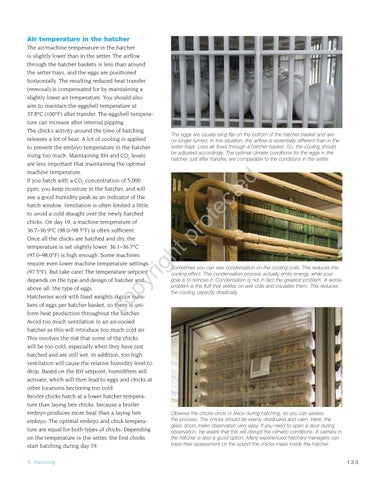Air temperature in the hatcher
pr ot
ec
te
d
The eggs are usually lying flat on the bottom of the hatcher basket and are no longer turned. In this situation, the airflow is essentially different than in the setter trays. Less air flows through a hatcher basket. So, the cooling should be adjusted accordingly. The optimal climate conditions for the eggs in the hatcher, just after transfer, are comparable to the conditions in the setter.
Sometimes you can see condensation on the cooling coils. This reduces the cooling effect. The condensation process actually emits energy, while your goal is to remove it. Condensation is not in fact the greatest problem. A worse problem is the fluff that settles on wet coils and insulates them. This reduces the cooling capacity drastically.
co
py
rig
ht
The air/machine temperature in the hatcher is slightly lower than in the setter. The airflow through the hatcher baskets is less than around the setter trays, and the eggs are positioned horizontally. The resulting reduced heat transfer (removal) is compensated for by maintaining a slightly lower air temperature. You should also aim to maintain the eggshell temperature at 37.8°C (100°F) after transfer. The eggshell temperature can increase after internal pipping. The chick’s activity around the time of hatching releases a lot of heat. A lot of cooling is applied to prevent the embryo temperature in the hatcher rising too much. Maintaining RH and CO2 levels are less important that maintaining the optimal machine temperature. If you hatch with a CO2 concentration of 5,000 ppm, you keep moisture in the hatcher, and will see a good humidity peak as an indicator of the hatch window. Ventilation is often limited a little, to avoid a cold draught over the newly hatched chicks. On day 19, a machine temperature of 36.7–36.9°C (98.0–98.5°F) is often sufficient. Once all the chicks are hatched and dry, the temperature is set slightly lower: 36.1–36.7°C (97.0–98.0°F) is high enough. Some machines require even lower machine temperature settings (97.5°F). But take care! The temperature setpoint depends on the type and design of hatcher and, above all, the type of eggs. Hatcheries work with fixed weights (kg) or numbers of eggs per hatcher basket, so there is uniform heat production throughout the hatcher. Avoid too much ventilation in an air-cooled hatcher as this will introduce too much cold air. This involves the risk that some of the chicks will be too cold, especially when they have just hatched and are still wet. In addition, too high ventilation will cause the relative humidity level to drop. Based on the RH setpoint, humidifiers will activate, which will then lead to eggs and chicks at other locations becoming too cold. Broiler chicks hatch at a lower hatcher temperature than laying hen chicks, because a broiler embryo produces more heat than a laying hen embryo. The optimal embryo and chick temperature are equal for both types of chicks. Depending on the temperature in the setter, the first chicks start hatching during day 19. 9. H at c h i n g
Observe the chicks once or twice during hatching, so you can assess the process. The chicks should be evenly distributed and calm. Here, the glass doors make observation very easy. If you need to open a door during observation, be aware that this will disrupt the climatic conditions. A camera in the hatcher is also a good option. Many experienced hatchery managers can base their assessment on the sound the chicks make inside the hatcher.
133








































































































